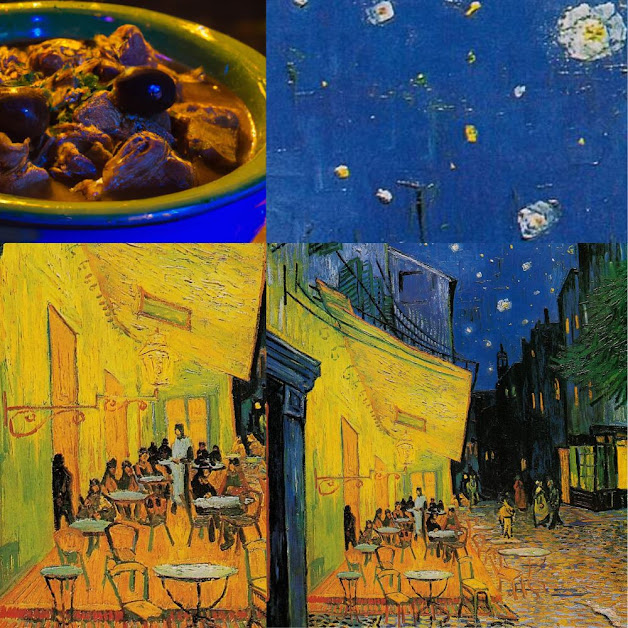Daube Provençale – Inspired by Van Gogh’s Café Terrace at Night
Recipe: Daube Provençale (Provencal Meat Stew)
Daube Provençale is a slow-cooked stew made with beef or other meats, such as pork or lamb, marinated in red wine, garlic, and various herbs and spices, like thyme, rosemary, and bay leaves. The marinated meat is then cooked with vegetables, such as carrots, onions, and tomatoes, which help to create a rich and flavorful sauce. The dish is typically cooked in a large, heavy pot called a "daubière," which has a tight-fitting lid to lock in moisture and flavors during the slow cooking process.
Ingredients:
- 2.5 lbs (1.1 kg) beef chuck or stew meat, cut into 2-inch (5 cm) cubes
- 1/4 cup (60 ml) olive oil
- 2 onions, thinly sliced
- 2 carrots, peeled and cut into 1-inch (2.5 cm) pieces
- 3 cloves garlic, minced
- 1 14.5 oz (411 g) can diced tomatoes
- 1 cup (240 ml) dry red wine (such as a Côtes du Rhône or Burgundy)
- 1 cup (240 ml) beef broth
- 1/4 cup (60 ml) brandy (optional)
- 1 strip orange zest, about 1 x 3 inches (2.5 x 7.5 cm)
- 2 bay leaves
- 1 sprig fresh rosemary
- 1/2 tsp dried thyme
- 1/2 tsp ground allspice
- Salt and freshly ground black pepper, to taste
- 1/2 cup (about 75 g) pitted black olives, such as Kalamata or Niçoise
- Chopped fresh parsley, for garnish
Instructions
Season the beef cubes with salt and pepper. Heat 2 tablespoons (30 ml) of olive oil in a large Dutch oven or heavy-bottomed pot over medium-high heat. Brown the beef in batches, turning to brown on all sides. Transfer the browned beef to a plate and set aside.
Add the remaining 2 tablespoons (30 ml) of olive oil to the pot. Add the onions and carrots, and cook for about 5 minutes until the onions are softened and slightly translucent.
Stir in the minced garlic and cook for another 1-2 minutes, until fragrant.
Add the browned beef back to the pot, along with the diced tomatoes, red wine, beef broth, brandy (if using), orange zest, bay leaves, rosemary, thyme, and allspice. Stir to combine.
Bring the mixture to a simmer, then reduce the heat to low. Cover the pot and let it simmer gently for 2-3 hours, or until the beef is very tender and the flavors have melded together.
About 15 minutes before the end of cooking, add the black olives to the stew and stir to incorporate.
When the daube is ready, remove the bay leaves and rosemary sprig. Adjust the seasoning with salt and pepper, if necessary.
Serve the daube over cooked egg noodles, mashed potatoes, or polenta, garnished with chopped fresh parsley
Vincent Van Gogh | Café Terrace at Night
"Terrasse du café le soir" or "Café Terrace at Night" is a painting by Dutch artist Vincent van Gogh, created in September 1888. This artwork showcases a vibrant night scene at a café on the Place du Forum in Arles, France. The painting is known for its rich use of color, unique composition, and striking nocturnal atmosphere.
In the foreground, the terrace of the café is depicted, with several tables and chairs arranged for customers to enjoy their drinks and meals. The café's patrons are portrayed as silhouettes, engaged in conversation or quietly enjoying their time. The waitstaff can be seen attending to the guests and moving about the terrace.
The cobblestone street extends into the background, where additional people can be observed walking and conversing. The surrounding buildings, illuminated by the warm glow of the café's gas lamps and a few windows, exhibit the architectural charm of the region. A large tree on the left side of the painting adds depth and balances the composition.
One of the most striking elements of "Café Terrace at Night" is van Gogh's use of color. The artist employed a vivid palette, with dominant shades of blue, yellow, and orange, creating a remarkable contrast between the warm, inviting atmosphere of the café and the cooler, more mysterious night sky. The brushstrokes are bold and expressive, which is characteristic of van Gogh's signature style.
Vincent Van Gogh
Vincent van Gogh (1853-1890) was a Dutch Post-Impressionist painter who is among the most famous and influential figures in the history of Western art. Despite his exceptional talent, van Gogh struggled with mental health issues throughout his life and received little recognition for his work during his lifetime. He created over 2,100 artworks, including around 860 oil paintings, most of which he made during the last two years of his life.
Born in Zundert, Netherlands, van Gogh pursued various careers before turning to art, including working as an art dealer and a preacher. His artistic career began in earnest in the late 1880s, during which he moved to Paris, where he was exposed to the works of the Impressionists and Neo-Impressionists. This experience greatly influenced his style, and he began incorporating brighter colors and more expressive brushstrokes into his paintings.
In 1888, van Gogh moved to Arles, in the south of France, seeking a brighter, more vibrant environment. This period, known as his "Arles Period," is characterized by some of his most famous works, such as "Sunflowers," "Starry Night Over the Rhone," and "Café Terrace at Night."










Comments
Post a Comment